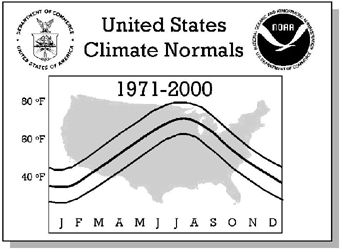
| The United States used a
standard "30-Year normal" in its official climate data records. The
National Climatic Data Center in Asheville (NCDC), NC is the official
location where the data are stored and the 30-year normals are
calculated. However, this 30-year normal or average is not recalculated
at the start of each new year. Instead, the 30-year normals are
computed once every 10 years. For example, the last 30 year normals
covered the period of 1961-1990 and have just been replaced by the
1971-2000 normals. The next set of 30-year normals will cover the
period 1981-2010. Year to year variation in weather in the U.S. can be
quite extreme, therefore the normals are not calculated each once every
10 years helping to smooth out the year to year variations.
The new 1971-2000 normals were integrated into the Nebraska Weather and Climate and Lincoln Weather and Climate Web sites in July 2002. Although this is considerably later than the cutoff date of December 2000 for the data going into the current 30-year normals, it took about one full year to quality check all of the data at the National Climatic Data Center. The normals were not released to the climate centers until Spring/Summer 2002. Is a
"Normal" the Climate You Would "Expect"? The NCDC official Internet site which has a large amount of background information on the 30-year climate normals can be found at: http://lwf.ncdc.noaa.gov/oa/climate/normals/usnormals.html
|